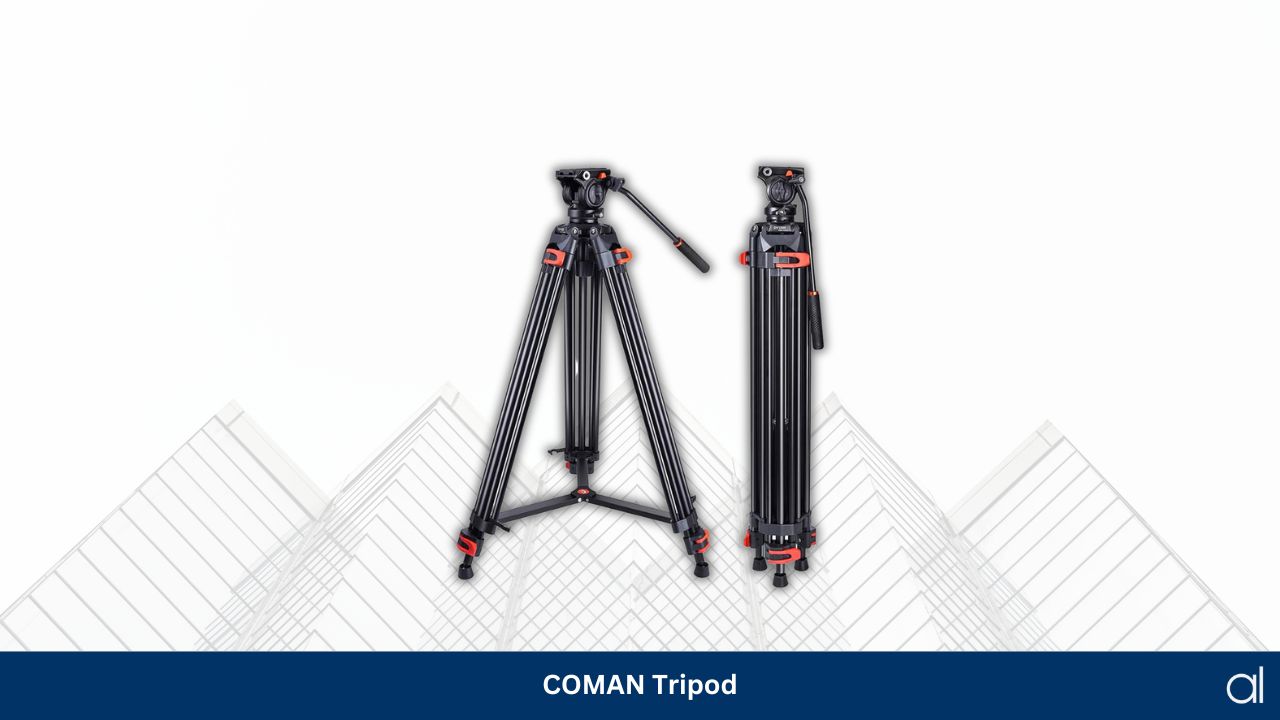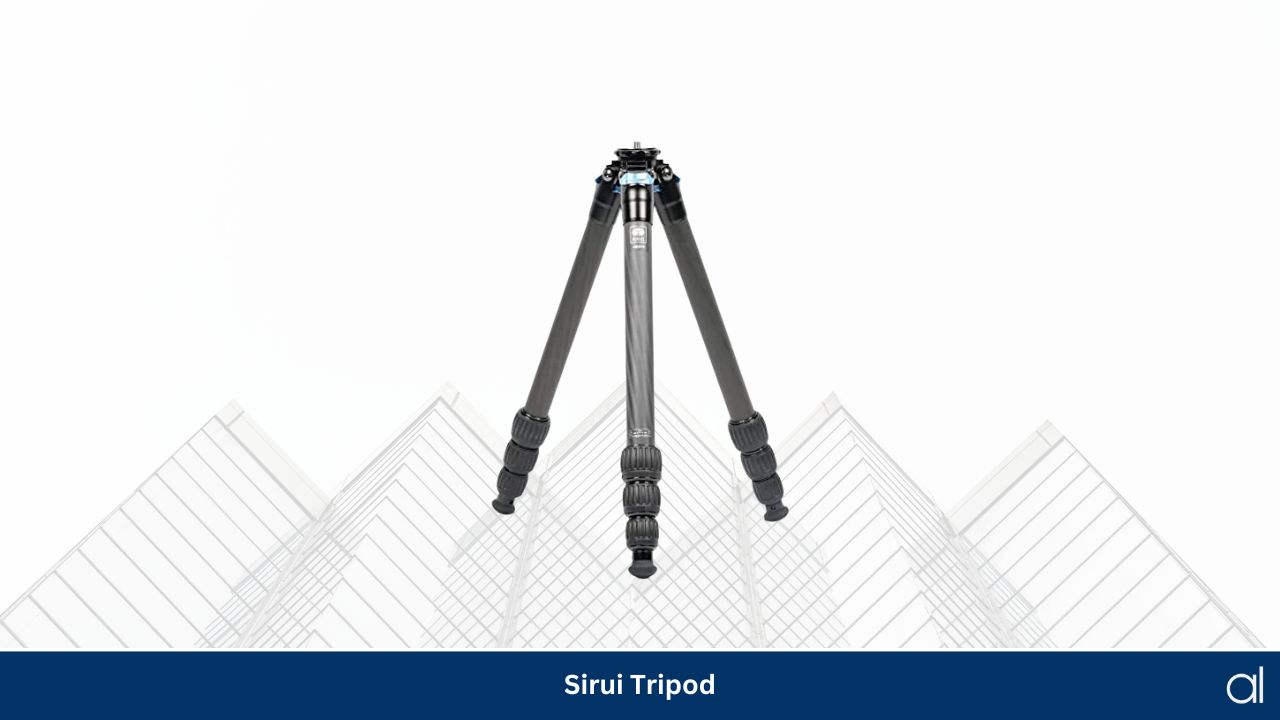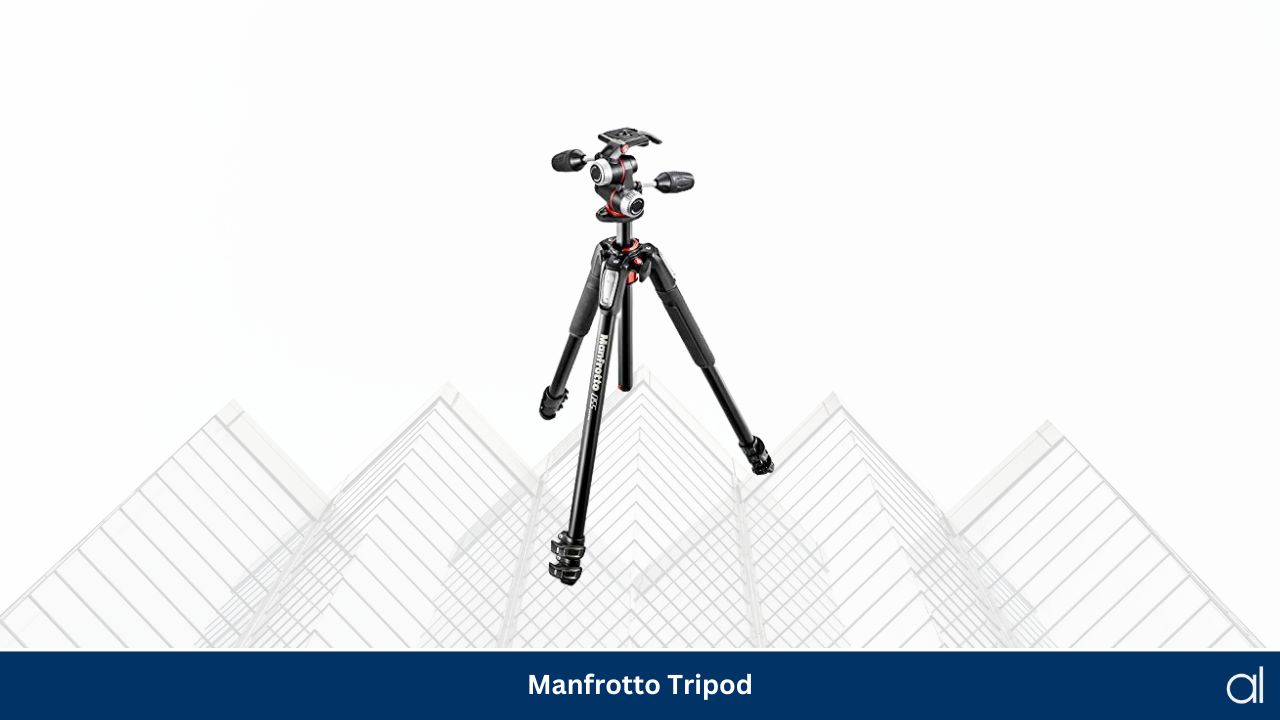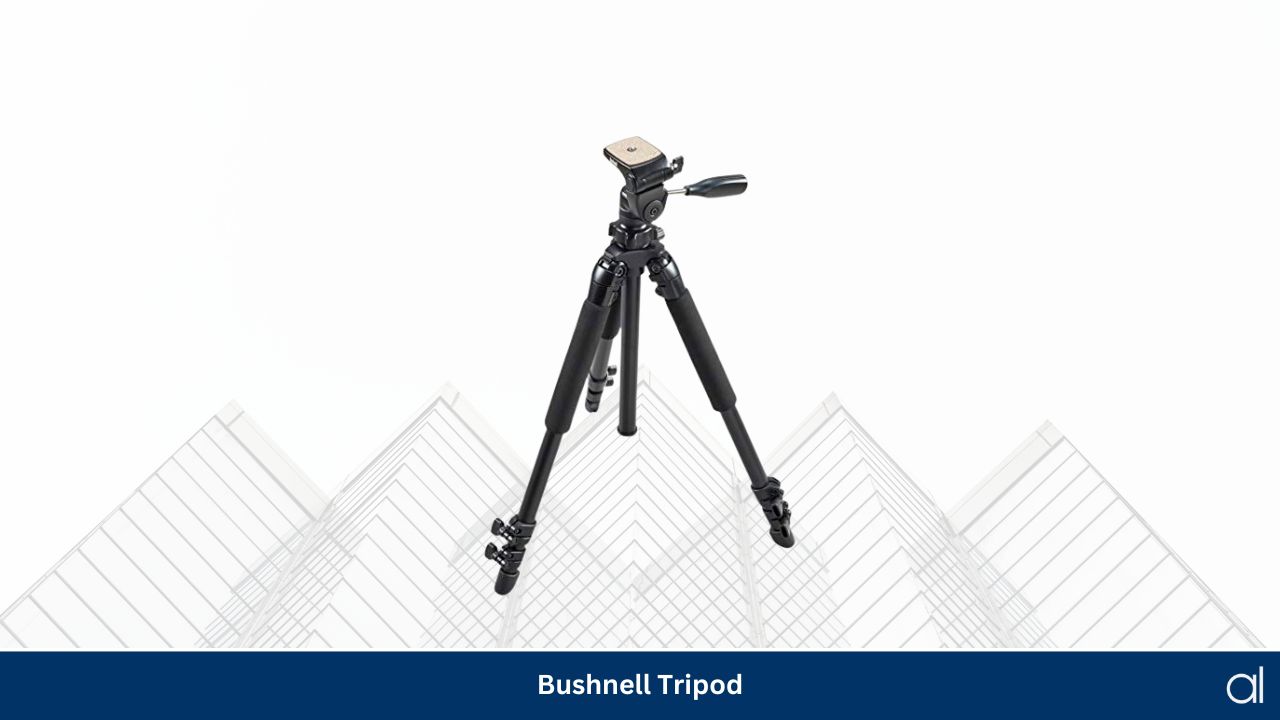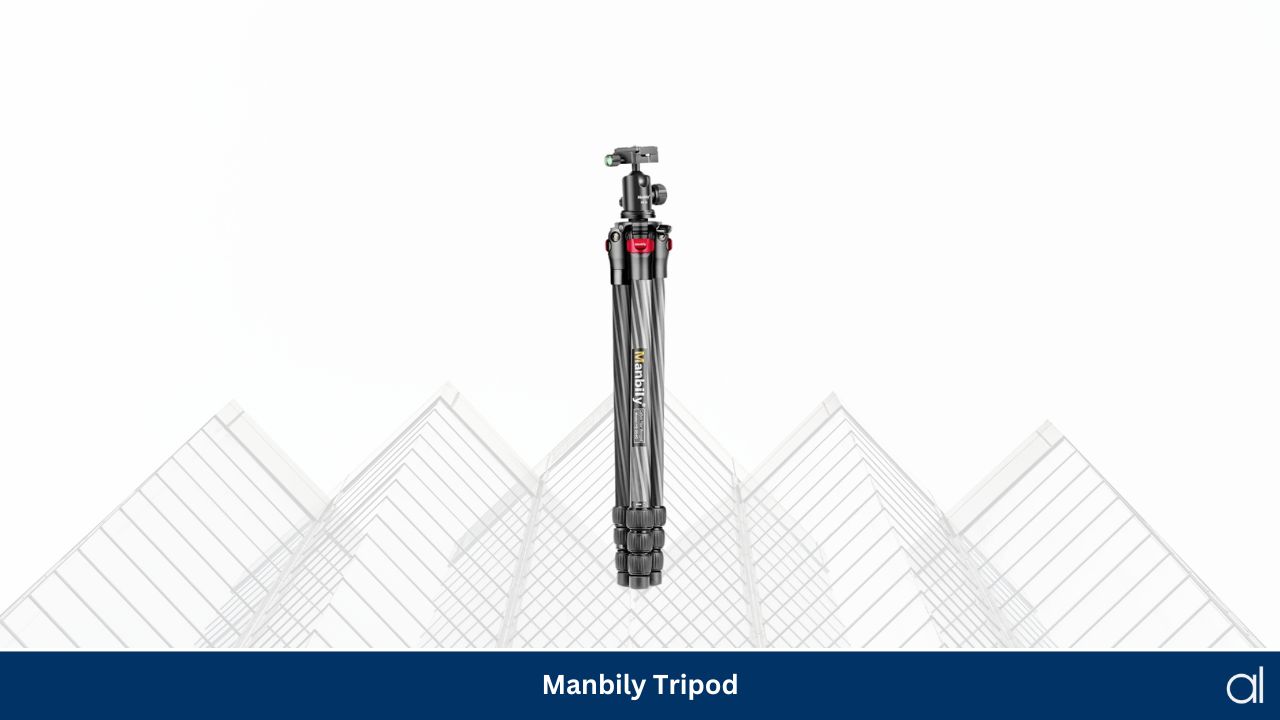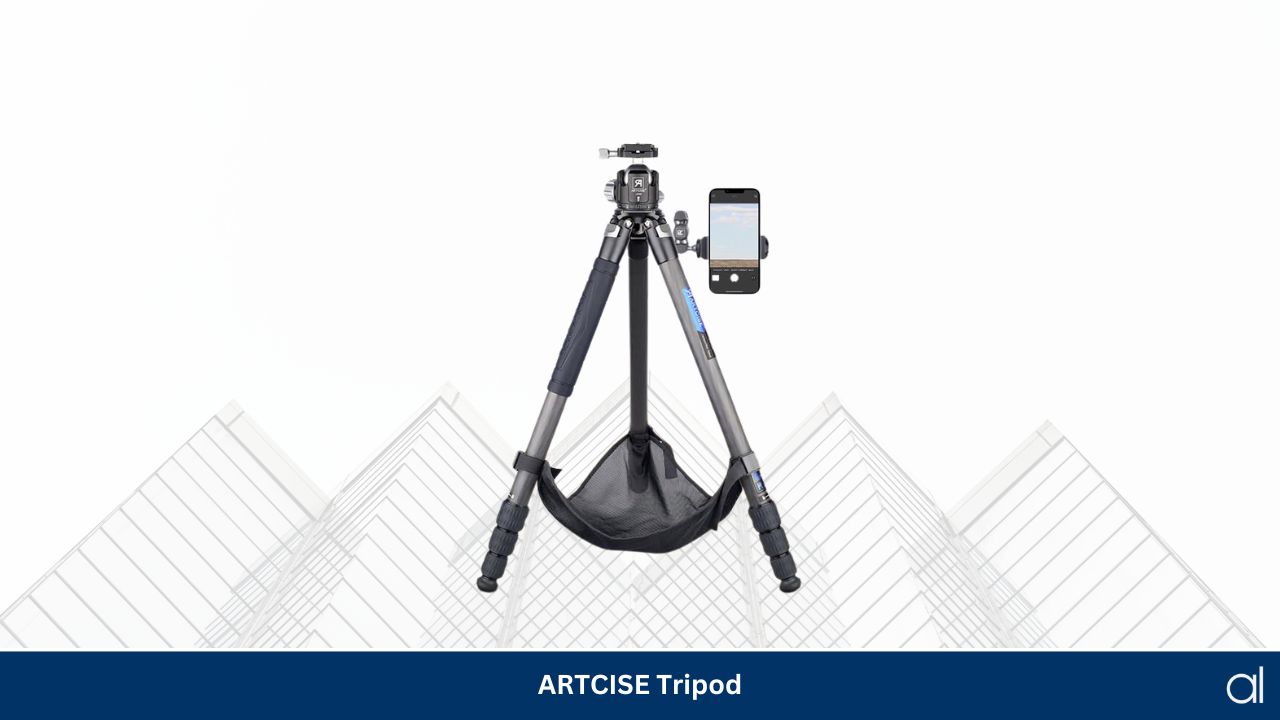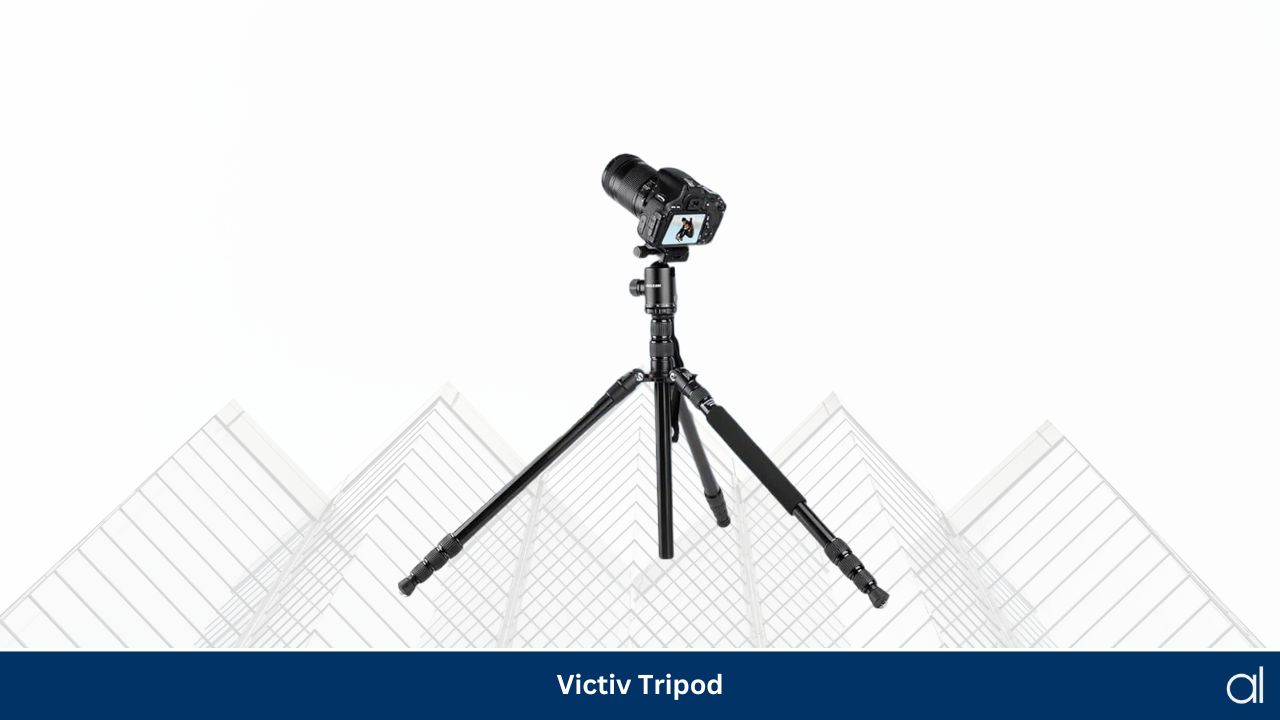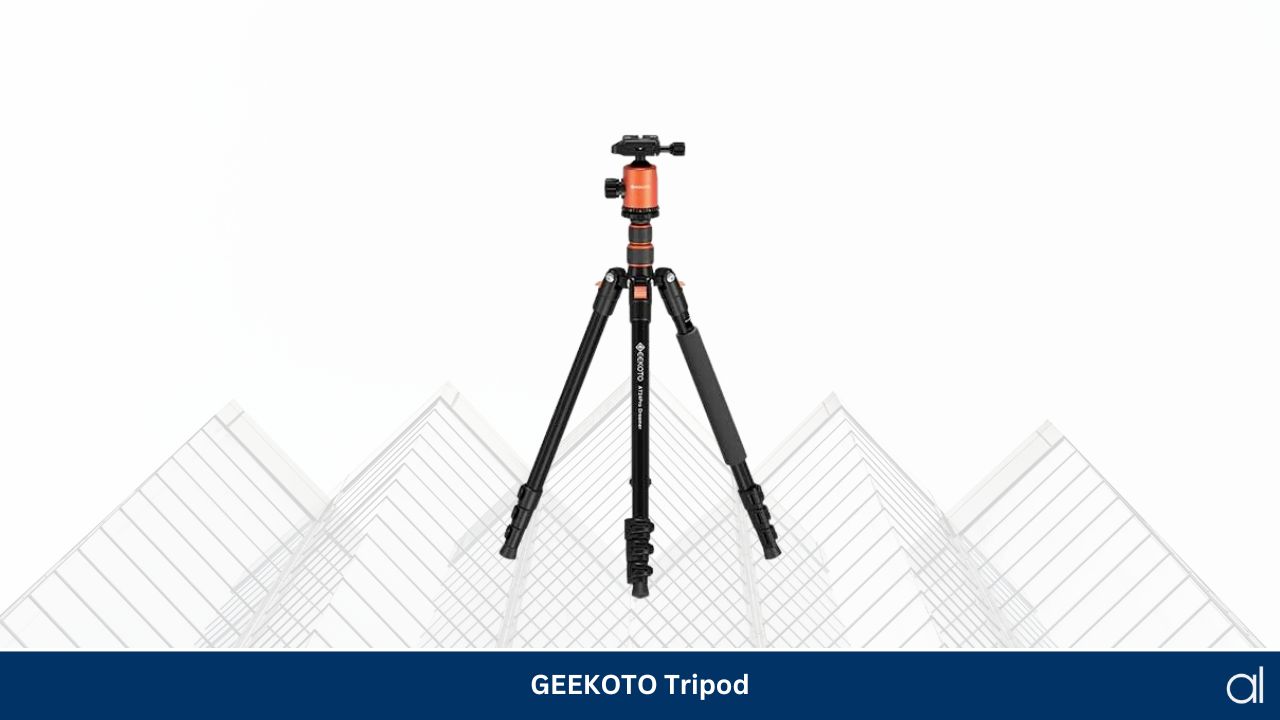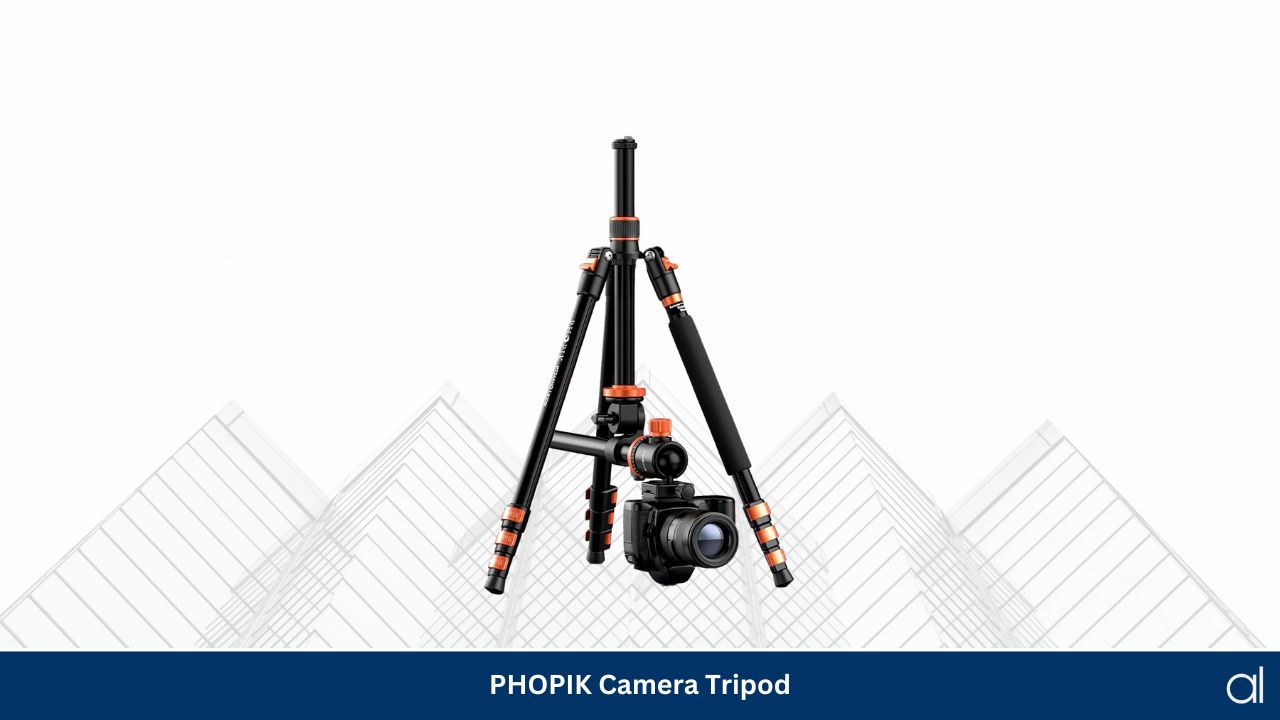A good tripod can help a professional real estate photographer take well-composed pictures without any unwanted camera movement. As such, it’s unsurprising that a tripod is an invaluable asset to real estate photographers. But if you’ve never owned a tripod before, choosing one can be a little challenging. After all, there are plenty of models to choose from.
So, to help you find the right tripod that suits your needs the best, I’ve created a list of the best professional-grade tripods. Find all the information pertaining to the best companion for your camera!
1. Best Overall: COMAN Heavy Duty Tripod
The COMAN DV1000 Heavy Duty Tripod is designed to be stable and easy to set up.
Made using an aluminum alloy, the DV1000 features a double-row tube and a 60mm bowl base that provide it with stability. From my time testing the tripod, I found that the mid-level spreaders keep the legs stable on both even or uneven terrain. Moreover, the legs feature adjustable rubber mats for added image stabilization.
It comes with a 360-degree fluid head that moves horizontally and suits multiple camera types, such as DSLRs, digital single-lens reflex camera or camcorders. The fluid head has built-in damping and balances itself dynamically, making its operation easy and smooth.
Additionally, the tripod is compatible with most camera brands, as it uses a ¼” and ⅜” screw in its circular quick-release plate. However, I found it a bit difficult to remove and disassemble at first, which can be a minor issue if you need to move it frequently.
You can also use the safety button on the left side of the fluid head to stop the camera from falling down. As for the maximum load, the DV1000 can hold up to 13.2 lbs, making it capable of holding most cameras without issue.
The product features a pan-tilt head with a range of -75 to +90 degrees, along with a 60mm ball head diameter. Its height can be adjusted from 35.6 to 72 inches, which is a fairly standard height range. And lastly, the tripod is covered by a 730-day limited warranty.
What We Like
- Easy to set up
- Stable on most surfaces
- Smooth and easy operation
- Compatible with most camera brands
What We Don’t Like
2. Best Carbon Fiber Tripod: Sirui Carbon Fiber Tripod
Designed for portability, the Sirui AM-284 is a lightweight tripod that can facilitate both indoor and outdoor shooting. It comes with a carry bag to further support its portability.
The material used primarily to make this tripod is carbon fiber, which is what makes this tripod weigh only around 2.69 pounds. And despite its low weight, I found the tripod to be stable enough on most surfaces. In particular, the ability to remove the rubber feet and replace them with steel spiked ones further add to its stability.
Featuring 4-section column legs, the AM-284 can be set up quickly and adjusted easily. It features an adjustable height range from 3.2 inches to 47.2 inches, which can suit several shooting requirements. That said, after spending some time with the product, I did feel that the maximum height setting could have been a little higher.
The AM-284 also features flexible angle adjustment for its carbon fiber legs that uses a semi-automatic pull button. You can choose from three fixed angle adjustments: -22, 55, and 85 degrees. The legs can be locked at a specific angle, making them quite flexible for shooting purposes.
And lastly, the tripod can hold up to 33.1 pounds, which I found to be sufficient for most photo and video camera types.
What We Like
- Lightweight and durable build
- Highly stable with removable feet
- Fast setup speed with 4-section column legs
- High load capacity
What We Don’t Like
3. Most Durable Tripod: Manfrotto 3-Section Tripod
The Manfrotto 055 Tripod is an aluminum construction with a focus on stability and easy operation. It can be used to pan the camera in three directions, and it comes with a pan tilt head as well.
This tripod was not designed for portability, evident by its high weight and heavy-duty aluminum frame. That said, the tripod is quite stable because of its height, keeping the gear from toppling over. Moreover, it has a wide range of height settings, from 24 to 70 inches.
Featuring a load capacity of 19.8 pounds, the Manfrotto tripod can support most medium-format cameras without issues. This is enabled by its high-quality aluminum frame, which is durable and can be used reliably without wear and tear.
And with its Easy Link attachment, the tripod can be converted into a portable photographic studio. You can attach an arm that comes with an accessory like LED lights or reflectors, which may make it versatile for various shooting conditions.
Lastly, the product features a flip-style leg lock that keeps its hefty legs steady in their places. The lock matches the sturdiness of the overall product and will last for a long time.
What We Like
- Highly durable
- Can pan cameras in three directions
- Features a maximum height of 70 inches
- Supports additional accessories
What We Don’t Like
4. Most Versatile Tripod: Bushnell Advanced Tripod
The Bushnell 784030 is an affordable tripod made for a stable photographing experience. This is a heavy-duty tripod that aims to be portable while offering high stability as well. Made using durable aluminum, the Bushnell tripod is capable of supporting photographic sessions on any terrain.
The tripod can be set up easily and quickly in most environments as well, featuring a 3-way tripod head and a quick-release plate. Judging from my time with the tripod, it was quite simple to attach or detach cameras and scopes using the quick-release plate.
Further, you can use the Bushnell tripod with several devices like binoculars, scopes, and cameras. This makes it a highly versatile tool that can be used for architectural and panoramic photography, as well as other purposes like bird-watching.
Its legs can be locked to different heights and angles individually, which suits uneven terrain. And its feet come with a non-slip coating that keeps it steady on any surface. The tripod can adapt to numerous terrains and requires only a quick setup on your part.
Once you’ve set it up, you can adjust its vertical height range from 18.3 inches to 63 inches. Moreover, the tripod can carry up to 11 pounds of weight, which is enough for most lightweight cameras. That said, the tripod doesn’t come with a carry bag to support its portability.
What We Like
- Legs with individual height/angle adjustments
- Compatible with various devices
- Non-slip feet for stability
- Affordable
What We Don’t Like
5. Best Portable Tripod: Manbily Carbon Tripod
Designed to be portable, the Manbily YS-254 tripod is compact and lightweight. Made from sturdy carbon fiber, the Manbily tripod is small enough to fit into any carry bag. For this, it makes use of a concealed hexagonal-shaped center column that is responsible for making it compact.
Its folding length is about 21 inches, and weighing 2.9 pounds, the tripod can be carried around easily. Despite this, the Manbily tripod can carry up to 22 lbs of weight, which is enough to carry most camera models comfortably.
The center column can be mounted within a few seconds, and if needed, it can be replaced with a shorter version as well. This enables the tripod to reach a minimum height of 7.8 inches, giving your camera access to extremely low-angle shots.
As for its maximum height, the Manbily tripod can be extended as high as 63 inches. Though the maximum height is fairly standard in the tripod space, the difference between minimum and maximum heights is significant. This may make it the preferred tool for all kinds of long-exposure photography.
Each column foot features three quick-lock knobs that enable the extension and retraction elements of the tripod. Additionally, each tripod leg can be separated from the main body and used as a monopod or trekking pole separately.
In my experience with the Manbily tripod, I found that the monopod works well as a photography tool. However, I did notice a slight wobble around the tripod head, which is secured using a single-set screw. This can lead to a few imprecise shots, which can be troubling.
What We Like
- High extension range
- Carbon fiber build
- Portable
- Detachable monopod
What We Don’t Like
6. Lightest Tripod: ARTCISE Carbon Fiber Tripod
Made using high-quality materials, the ARTCISE AS85C tripod is a model in the premium range. The tripod features 10-layer carbon-fiber-reinforced polymers and aviation-grade aluminum alloy as its primary materials. This affords the ARTCISE tripod high durability while being lightweight.
At 55.1 pounds, the ARTCISE tripod comes with the highest load capacity in the segment. This is reinforced by its high maximum leg diameter, which is 32.5mm. Since the legs are spread far apart, the tripod is able to hold more weight than what would be possible otherwise.
The ARTCISE tripod comes with a 44mm center-of-gravity ball head that reduces its center-of-gravity by 15%. This affords the model higher stability while weighing about 0.99 pounds.
Moreover, you can use the tripod as a monopod or a trekking pole by inverting and detaching the center column. I found that the stability of the monopod only slightly falls short of its tripod counterpart, which is to be expected.
As for the angles and height ranges, the tripod offers several options. You can choose from 70, 42, and 12-degree angles, along with height settings ranging from 10.4 inches to 72.6 inches. For macro photography, these options can be sufficient in most scenarios, except maybe for low-angle shooting.
And lastly, the tripod is covered by an 8-year warranty, with all parts being cleanable, serviceable, and replaceable.
What We Like
- Weights 0.99 lbs
- High stability with center-of-gravity ball
- Sturdy build
- Wide range of photography settings
What We Don’t Like
7. Most Affordable Tripod: Victiv Heavy Duty Tripod
In the affordable price range, the Victiv AT24PRO tripod may be an option to consider as your first tripod. It features aluminum and natural rubber as its manufacturing materials, making it a durable model.
The tripod supports 360-degree panoramic shooting with an independent pan lock, allowing you +90 or -70-degree tilt camera positions. You can use the cut-notch on the side of the tripod head for this, giving you access to all photography angles. It also comes with a 0.25-inch quick-release plate mount that supports most types of cameras, phones, binoculars, and more.
With thicker legs that spread wide, the tripod is fairly stable, maintaining a strong grip on surfaces. Its feet have a non-slip coating that increases strong friction and prevents it from sliding over excessively.
The Victiv tripod has some of the highest extension ranges on this list, ranging from 18.5 to 80 inches. While the upper limit is quite high, the lower limit could have been a little lower to facilitate low-angle shots.
These limits change even further when the tripod is converted into a monopod. The monopod version ranges from 31 to 86 inches, making it more suited for high-angle shots and less for low-angle ones.
It weighs only about 3.7 pounds, which is fairly light for an aluminum tripod. Moreover, its maximum load capacity is 35 pounds, allowing it to support most cameras.
What We Like
- High maximum height limit
- Low weight
- Can be converted into a monopod
- Affordable
What We Don’t Like
8. Best Aluminum Tripod: GEEKOTO Aluminum Tripod
The GEEKOTO AT24PRO is another tripod in the affordable range that is built primarily using aluminum. Weighing about 3.37 pounds and a load capacity of 17.6 lbs, the tripod may be an option to consider.
This tripod features height adjustments ranging from 19 to 77 inches, emphasizing high-angle shots over low-angle ones. The adjustments can be performed within seconds by using its quick-release flip locks. Additionally, the tripod features a 360-degree rotatable ball head that can support panorama shots through free angles.
As for portability, the GEEKOTO tripod can be folded to be about 19 inches in length, which matches its minimum extension setting. Suffice it to say that the tripod is not particularly portable.
Its legs can be opened in three different opening angles that provide you with a steadier shot. These legs can be adjusted individually to suit multiple levels of incline to make clicking pictures easier.
What We Like
- Affordable pricing
- Wide range of height settings
- Weights about 3.37 lbs
- Individually-adjusting legs
What We Don’t Like
9. Best Convertible Tripod: PHOPIK Camera Tripod
Lastly, let’s take a look at the PHOPIK PT24ANG aluminum tripod that is geared for stability. With a maximum load capacity of 22.04 pounds, the tripod provides enough stability to support most camera types and scopes. The tripod has ⅜” quick-release skewer screws to attach to DSLR cameras, scopes, etc.
Its adjustable legs are made using aluminum that can be freely extended to the maximum height of 77 inches. Additionally, it can be folded down to 18.3 inches, giving you a wide range of height options.
Should you need to use one of the legs as a monopod, the PHOPIK tripod supports that function as well. As I experienced with this product, the monopod is slightly less stable than its tripod counterpart.
The PHOPIK tripod has a universal shaft with 360-degree horizontal movement capability. Along with it, the metal ball head can also be rotated 360 degrees to expand the range of motions for a camera.
And to help keep the tripod stable at eye level and the shots consistent, the PHOPIK tripod comes with a spirit level. That said, a camera with a heavy lens may affect the shot stability to a degree, which can be an undesirable element of the product.
On top of that, the central column of the tripod can be inverted to get closer to the subject of your HDR photography. It can also be elongated, giving you access to shots at a small angle.
What We Like
- Stable aluminum tripod
- Maximum height of 77 inches
- Invertible central column
- Bubble levels for stability
What We Don’t Like
Best Tripods for Real Estate Photography Comparison Table
| Best Tripods | Tripod Weight | Material | Maximum Height | Lock Type | Load Capacity |
|---|---|---|---|---|---|
| COMAN Heavy Duty Tripod | 9 lbs | Aluminum | 72 inches | Flip lock | 13.2 lbs |
| Sirui Carbon Fiber Tripod | 2.69 lbs | Carbon fiber | 47.2 inches | Twist lock | 33.1 lbs |
| Manfrotto 3-Section Tripod | 7.7 lbs | Aluminum | 70 inches | Flip lock | 17.6 lbs |
| Bushnell Advanced Tripod | 6 lbs | Aluminum blend | 63 inches | Twist lock | 11 lbs |
| Manbily Carbon Tripod | 2.9 lbs | Carbon fiber | 63 inches | Lever lock | 22 lbs |
| ARTCISE Carbon Fiber Tripod | 0.99 lbs | Carbon fiber and aluminum | 72.6 inches | Twist lock | 55.1 lbs |
| Victiv Heavy Duty Tripod | 3.7 lbs | Aluminum, rubber | 80 inches / 86 inches (as a monopod) | Twist lock | 35 lbs |
| GEEKOTO Aluminum Tripod | 3.37 lbs | Aluminum | 77 inches | Flip lock | 17.6 lbs |
| PHOPIK Camera Tripod | 5.29 lbs | Aluminum | 77 inches | Flip lock | 22.04 lbs |
Architectural Real Estate Tripod Buyer’s Guide
When looking for real estate photography tripods, you may be wondering what to look for in a professional-grade model. A good tripod should facilitate three things for it to be considered the best: camera-shake elimination, good verticals, and consistent composition and height.
Camera shake results in low image quality, no matter what kind of camera you have. This can be seen in all types of capture devices, from cell phones to high-end DSLRs.
Moreover, a shaky camera can eliminate details from the picture, which is the last thing a screen-printed architectural photograph should omit. By steadying the camera and keeping it still until you physically move it, a tripod eliminates camera shake completely.
Next, a good tripod should help you maintain good verticals, meaning that the angle of vertical lines matches from one framed picture to the next. These lines can be present between objects, on a countertop, table, ceiling, floor, and more. And once you maintain straight lines, you reduce the likelihood of lens distortion significantly.
And finally, a tripod keeps your pictures consistent in terms of composition and height from one room to the next. This is something that cannot be achieved while free-handling the camera, as it becomes difficult to gauge the change in height or angle. A consistent look is a must for any collection of cardstock-printed real estate photos.
If the tripods you’re browsing fit these qualities, you can further narrow it down by looking into their more specific aspects. Tripods come from several brands in all kinds of specifications, so you can keep the following five qualities in mind to make the choice easier.
1. The Make
In my experience, the manufacturing materials in a tripod impact its durability and weight. This is why most professional-grade tripods are made using carbon fiber, which is a lightweight and sturdy material.
With that being said, carbon fiber tripods can be quite expensive, particularly if you’re just beginning your real estate or interior photography journey. You can look at aluminum as an alternative, which is more affordable but also noticeably heavier. Aluminum is also not quite as durable as carbon fiber, which can be a point of contention if your work requires a sturdy tripod.
So, consider a carbon fiber tripod brand if the cost isn’t an issue and aluminum if you’re looking for an option that’s easier on the wallet.
2. The Durability
Having to replace a tripod twice a year can become quite tedious, particularly if you use it frequently. Moreover, a tripod failing in the middle of a shooting session can be troubling, which is why you would want one that is reliably durable.
A highly durable tripod goes a long way, especially if you spend a lot of time traveling. You can rest assured knowing that no matter what, the tripod will remain safe and ready to be used when needed.
Another thing to be mindful of about a tripod is its rigidity. Rigidity goes hand-in-hand with durability, being the measure of the strength of a tripod. When using one, its moving parts should remain strong enough to comfortably hold the mirrorless camera, no matter how heavy the lens may be.
Moreover, the tripod should not topple over during use, or it could damage your camera and the lens.
3. The Height
The maximum height of a tripod is always one of the most important points to consider when purchasing one.
With property photography in particular, you will need to take pictures from a higher point, which is where a greater maximum height will benefit you. After all, you can’t photograph with a drone in residential areas for aerial shots.
4. The Size And Weight
It’s important to consider how much you will be moving it, be it from a car or inside the premises of your photographing location. Architectural photography often requires plenty of movement, which can be hindered by a hefty tripod. Moving such tripods requires plenty of effort and is quite slow as well, wasting plenty of time in the process.
So, the tripod of your choice must be light and small in size. Moreover, its size should also be compact enough to fit in your bag or case easily when disassembled and stowed away.
5. The Lock Type
Primarily, there are two types of locks for tripod legs: twist locks and lever or flip locks. The core purpose of each is to keep the tripod legs bunched together for storage, which they approach in different ways.
Twist locks are simple in their functionality, where you can twist the knob to undo or tighten the lock. Owing to their simplicity, the locks are easy to operate, but it can take some time to secure them properly.
On the other hand, a lever lock makes use of latches to lock and unlock the tripod. Adjusting the height is precise and quick with such locks, and they operate rather quickly. The issue with lever locks is that they don’t last quite as long and can have trouble securing them once they become old enough.
At the end of the day, it depends on which type of lock you prefer personally. There are pros and cons to each lock type, so feel free to try them out and make a decision from experience.
What is the ideal tripod height range for real estate photography?
An ideal tripod should have settings that allow for both high-angle and low-angle shots. As such, the best tripod maximum height can be around 50-63 inches. At its lowest, it may be able to go as low as 10-15 inches.
Of course, this depends on the subject matter and the location you will be shooting from. Some tripods have an even wider height range, going as low as four inches off the ground and as high as 85 inches.
Is a monopod better than a tripod for architectural photography?
Monopods trade stability for mobility, which can make all the difference between a sharp picture printed by a canvas printer and one with motion blur. At the same time, it isn’t as restrictive as a tripod, which can be preferable in certain circumstances.
Tripods can carry more weight and take less time to adjust for a shot, which is what matters more in architectural photography. You’ll want your shots to be as stable as possible without any loss in detail. They are more suited for macro photography, making them more suited as a part of your real estate photography equipment.
Of course, many tripods can be converted into monopods, which can be a boon for those who need to move frequently during a photography session.
What are the different types of tripods?
There are no less than five kinds of tripods that cater to different circumstances and photographing needs. These include all-in-one tripods, travel tripods, studio tripods, pocket tripods, and specialized tripods.
An all-in-one tripod is generally the most affordable and portable of the bunch, with tripod heads and legs connected permanently to the central column. It makes for a good beginner’s tripod, which can help you gauge what you need from the upgraded model.
A travel tripod is primarily designed for easy mobility through portability. It’s a light tripod type that can be stowed away in a bag quite easily without taking up much space.
If you’ve been to a photography studio before, you’ve likely seen a studio tripod. It’s a sturdy tripod type that is too bulky to carry around. If you don’t travel around much or don’t need to move to different places to take shots, a studio tripod may serve your needs well.
As the name suggests, pocket tripods are designed to be carried around in your pockets. Their maximum height is somewhere between four and eight inches, and they are tailored for quick shots. Of course, these are not suited for architectural photography at all, given the lack of options and height range. The usability of a pocket tripod is limited to self-portraits.
Lastly, you can find several specialized tripods that offer various features like suction cups or flexible tripod legs.
What is a good average weight for a tripod?
For real estate photography, a good average weight would range between 3 and 9 lbs. The reason for this is that the tripod becomes too cumbersome to carry around the shoot location.
That said, if you travel frequently with a tripod, then its ideal weight range would be between 1.5 to 3 lbs. Ideally, you would want to carry as little weight as possible to prevent yourself from tiring out too soon.
A good tripod should be light and sturdy with a decent height range to allow you to take scenic shots for a real estate agent. With it, your pictures will spare no details after being screen printed or projected on a large screen. But choosing one can be quite tricky, especially since so many models are capable of achieving this.
Based on my experience with the products, I’ve found the COMAN tripod to be the best tripod for real estate photography. The DV1000 balances feature with an affordable price tag while being light and easy to carry around, making it a high-quality tripod.
That said, other tripods like the Manfrotto 055 and Sirui AM-284 can be equally as good, based on your specific needs. At the end of the day, all that matters is that the professional tripod fulfills your needs, making you the sole arbiter of the choice.

